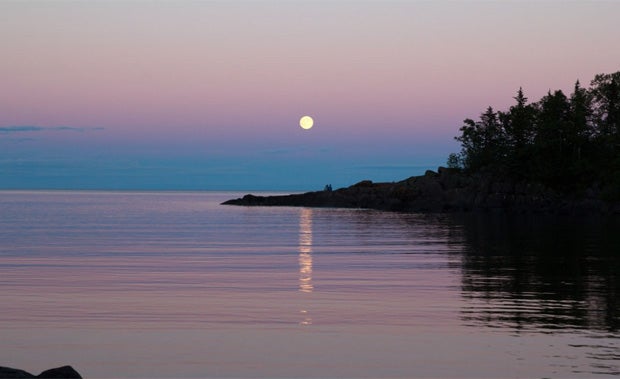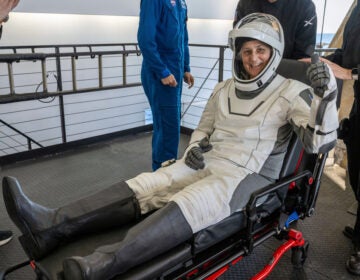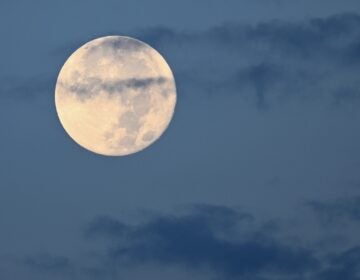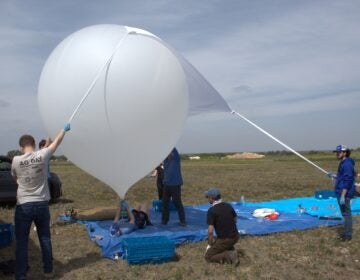Dog day night viewing highlights
ListenMoon is full tomorrow night, so watch as the moon rises as the sun sets or moon sets as sun rises. Venus and Saturn are low in the west after sunset, Jupiter and Mars are in the pre-dawn east. 24 ago Saturday, NASA’s Voyager 2 made its historic close fly-by of Neptune. And Sunday 31 years ago, NASA’s Voyager 2 flew by Saturn.
August 19, 2013
[Dave Heller] During these dog days of summer, let’s go night sky hunting for canis constellations with Derrick Pitts, chief astronomer at the Franklin Institute. Derrick, with clear skies, what are the chances of spotting Big Dog or Little Dog this week?
[Derrick Pitts] Actually not very good, because these are constellations that are up during the day with the sun, hence the name The Dog Days of Summer. It was thought by ancient observers that the light from the star in the sky at the same time during the day with the sun made it extra hot. We know that’s not really the case, but, we have other objects that are easily visible in the evening sky. One of my favorites of course is the bright constellation Signus Swan. If you’re outside in the evening and you face east, you’ll find not quite directly overhead, but it’s part of the northern cross you can identify without too much difficulty. Toward that star is the direction in which our solar system is heading. Zooming in that direction the entire solar system of course has its motion around the center of the galaxy; so our star is heading in that direction. It’ll take us a little while to get there, several hundreds of millions of years, but we’re headed off in that direction. Now the bright star Vega that’s part of the triumbrant of summer stars of the summer triangle, directly overhead at about 10 p.m. is about 26 lightyears away. So the light that we see coming from that star today, tonight, left that star some 26 years ago.
“The bright star Vega that’s part of the triumbrant of summer stars of the summer triangle, directly overhead at about 10 p.m., is about 26 lightyears away. So the light that we see coming from that star today, tonight, left that star some 26 years ago.”
Derrick Pitts
-

Vega. Photo credit: Martin S Mitchell
Derrick, for lovers of planets overhead, what’s there to be seen?
Depends when you want to see it. If you’d like to go out in the evening, you can see Saturn and Venus over in the southwestern sky, both rather low. Saturn is approaching Venus as the rest of the month goes on; you’ll see how those two come close together. If we move around to the morning sky before sunrise, we find Jupiter and Mars in the predawn sky, about an hour before sunrise we can see them without too much difficulty. So we have plenty of planets — two in the evening sky, two in the morning sky.
Hey, remember that tune “Sunrise, moonset…”?
Ah yes, we can see the moon rising as the sun sets tomorrow night. This is the condition of what happens when we have full moon. Part of the definition, the moon rises as the sun sets. So you can catch a couple of interesting things; again, you can see the moon rising as the sun sets tomorrow night, or, you can see the moon set as the sun rises on Wednesday morning. But the other interesting thing you can do is you can watch as the moon rises about 45 minutes later every evening after sunset, going forward towards the next phase of the moon, which would be last quarter. And what you’re actually seeing night to night is the effect of the moons orbital speed changing its rise time for us as we observe here from the Earth.
-

Full moon rising at sunset. Photo by Flickr user Teresa Boardman
Derrick, we have a moment left and let’s voyage to the days of Voyager.
If we go back in time, about 36 years ago, we’ll come to the time when two space craft — Voyager 1 and Voyager 2 — left this planet headed out to the depths of our solar system to bring us greater information, much better information and much better pictures of the outer planets of the solar system, particularly Jupiter and Saturn. They were scheduled to do a close fly-by of those planets and at some distance get some information about Uranus and Neptune. Well, coming up this Saturday, we have the 24th anniversary of when Voyager 2 flew by Neptune. And on Sunday, we have the 31st anniversary of when Voyager 2 flew by Saturn. Now the interesting thing about this is that, of course, it was the first fly-by of Saturn and then the first fly-by of Neptune. And one is 24 years ago and the other is 31 years ago. But these spacecraft are still operating today even though they are at incredible distances from us. Now we can talk about miles, but there’s another way we can measure how far out they are. So let’s take Voyager 2 for example: Voyager 2 is 14.1 light-hours away. That means that the speed of light, a signal we send on a one way trip will take 14 hours to get there. That’s half a day of travel time. Voyager 1, which is even farther out, takes 17.8 hours to send a signal back to Earth and likewise back to the spacecraft.
-

NASA’s robot spacecraft Voyager 2 made this image of Saturn as it began to explore the Saturn system in 1981. Saturn’s famous rings are visible along with two of its moons, Rhea and Dione which appear as faint dots on the right and lower right part of the picture. This photo was taken January 18, 1998. Credit: Voyager 2, NASA
-

Voyager 2 captured this image of Neptune in 1989. Dark, cold and whipped by supersonic winds, Neptune is the last of the hydrogen and helium gas giants in our solar system. More than 30 times as far from the sun as Earth, the planet takes almost 165 Earth years to orbit our sun. In 2011 Neptune completed its first orbit since its discovery in 1846. Credit: Voyager 2, NASA.
Is Voyager 1 still in our solar system?
What a great question. This is something scientists are trying to define even as we speak. There has been a lot of discussion among the planetary science community about exactly where it is at the boundary of our solar system. And one of the most interesting things we discovered is that scientists said we could tell that we’re outside of the solar system when we get a change in the kind of energy that’s been detected by the spacecraft. But the signal that scientists are receiving, very interestingly, sort of showed inside-outside-inside-outside. So scientists weren’t sure what they actually interpreted that to mean. Is that the very outer edge of the sun’s solar wind sort of bounces back and forth, and was bouncing back and forth sort of over the position of the spacecraft. So it seemed as if we were inside then outside then inside then outside. So as we keep moving out, we know the spacecraft will eventually pass the boundary of the solar system and be in interstellar space. Right now we’re still on the boundary of that, trying to determine if we are indeed all the way outside.
But in those moments, or days or weeks or months when we were outside, we were truly outside the solar system at that point.
Outside what we would call the boundary of the extent of the sun’s solar wind reach. And that’s the point where the influence of the sun’s solar wind is now less than the impingement of the environment of interstellar space.
If one could train that camera back toward our solar system from Voyager, would our sun look any larger or more significant than other close by stars?
Oh sure, actually it would. Even if at that distance, our star still looks very, very bright. You know, we measure magnitudes and the lower the number, the higher the brightness of the star. So for very bright stars, they might be a first magnitude (magnitude 1) or magnitude zero. Well these spacecrafts still see the sun as a negative 16 magnitude star. So that’s pretty intense. We can’t say that about any other object in the sky, not even the brightest planets — Venus gets to be a negative 4 magnitude, Jupiter can be negative 2 — so negative 16 is really very intense as a star still seen from that distance.
-
What is solar wind?
WHYY is your source for fact-based, in-depth journalism and information. As a nonprofit organization, we rely on financial support from readers like you. Please give today.




